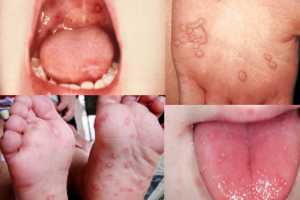Author: Brit Long, MD (@long_brit, EM Attending Physician, San Antonio, TX) // Reviewed by: Alex Koyfman, MD (@EMHighAK)
Welcome to EM@3AM, an emDocs series designed to foster your working knowledge by providing an expedited review of clinical basics. We’ll keep it short, while you keep that EM brain sharp.
A 23-year-old male presents with recurrent episodes of global headache, flushing, sweating, and palpitations. These episodes first started 1 month ago. They occur several times per day and last less than one hour. He has also noted a 10-pound weight loss since these episodes started. He has no past medical or surgical history.
Exam reveals blood pressure 183/108 mm Hg, HR 1114 beats per minute, RR 18, temperature 98.4 C, saturation 98% on room air. His skin is flushed. Your cardiovascular, pulmonary, abdominal, and motor and sensory exams are otherwise normal.
What is the likely diagnosis?
Answer: Pheochromocytoma
Background: Pheochromocytoma is a rare adrenal gland tumor arising from chromaffin cells in the adrenal medulla, but it may arise from other paraganglia. These extra-adrenal tumors have a greater likelihood of being malignant and metastasize.
- The prevalence approaches 0.6% in adults who present with hypertension, but the overall incidence is 0.05%.
- The majority of cases are sporadic.
- Up to 10% of cases have an underlying condition associated with the tumor: multiple endocrine neoplasia type II, von Hippel-Lindau disease, Sturge-Weber syndrome, neurofibromatosis type I, tuberous sclerosis.
10% Rule
- 10% arise in locations other than the adrenal gland
- 10% are malignant (higher rates of metastases to bone, liver, and lung)
- 10% are bilateral
- 10% are familial
- 10% occur in pediatric patients
- 10% are not associated with hypertension
- 10% have calcifications
Presentation:
- Recurrent episodes or paroxysms lasting < 1 hour with headache, anxiety, diaphoresis, flushing, alternating elevated and normal blood pressure, palpitations, tachycardia, tremor
- End organ injury
- Cardiac dysfunction (myocardial infarction, dissection, arrhythmia, shock, myocarditis, cardiomyopathy, acute peripheral ischemia)
- Pulmonary (cardiogenic or non-cardiogenic edema)
- Gastrointestinal (may prevent with several abdominal pain, acute GI bleeding)
- Renal (acute kidney injury/failure)
- Neurologic complications (visual changes, hemorrhagic stroke, seizures, hypertensive encephalopathy)
- Weight loss
Differential:
- Hypertensive emergency, myocardial infarction, sympathetic crashing acute pulmonary edema, stroke, intracranial hemorrhage, PRES, polycystic kidney disease, renal injury/glomerulonephritis, urinary obstruction, Cushing’s syndrome, hyperthyroidism, hyperaldosteronism, volume overload, autonomic dysreflexia, preeclampsia/eclampsia
ED Studies and Assessment:
- Based on differential and patient presentation, hemodynamic, and respiratory status: CBC, TSH, renal and liver function, troponin, VBG, extended electrolytes, CK, urinalysis, hCG in females
- Laboratory testing typically includes erythrocytosis, hyperglycemia, hypercalcemia
- Electrocardiogram (ECG) to evaluate for myocardial ischemia
- Chest x-ray if respiratory symptoms are present
- Head imaging (CT) if neurologic symptoms present
- Abdominal imaging can localize tumor
Diagnosis:
- Includes plasma free and fractionated metanephrines; urinary fractionated metanephrines/catecholamines
- Imaging does not typically differentiate malignant from benign pheochromocytomas
- CT of the abdomen and pelvis can be used to evaluate for the tumor, with sensitivity approximating 90%
- Tumors tend to be > 3 cm at presentation; most tumors are present in the abdomen (98%)
- Tumors tend to enhance most in the portal venous phase
- Modern day contrast may be used in evaluation and is not a contraindication
- Ultrasound may demonstrate a sold or cystic mass
- Magnetic resonance imaging (MRI) has a sensitivity of 98%
- Other imaging includes nuclear medicine and PET scans
- CT of the abdomen and pelvis can be used to evaluate for the tumor, with sensitivity approximating 90%
Treatment: Definitive treatment includes surgery, and if the tumor is completely resected, hypertension resolves. Treatment depends on whether the patient is in hypertensive crisis.
- Hypertensive crisis
- Alpha blockade
- Phentolamine (5 mg IV every 2-4 hours) or phenoxybenzamine
- Nicardipine may be used
- Beta blockade several days later
- This must be started after alpha blockade, as unopposed alpha activity may result in hypertensive emergency
- Surgical resection
- Alpha blockade
Disposition:
- Consult endocrinology if suspecting the disease.
- If disease confirmed and the patient presents with hypertensive crisis, admission is warranted.
- If the disease is suspected but not confirmed and the patient is stable, discharge with follow up for definitive testing is possible.
References:
- Tsirlin A, Oo Y, Sharma R, et al. Pheochromocytoma: a review. Maturitas. 2014;77 (3): 229-38.
- Blake MA, Kalra MK, Maher MM, et al. Pheochromocytoma: an imaging chameleon. Radiographics. 2004;24(suppl1): S87-99.
- Leung K, Stamm M, Raja A, et al. Pheochromocytoma: the range of appearances on ultrasound, CT, MRI, and functional imaging. AJR Am J Roentgenol. 2013;200 (2): 370-8.
- Zuber SM, Kantorovich V, Pacak K. Hypertension in pheochromocytoma: characteristics and treatment. Endocrinol Metab Clin North Am. 2011;40 (2): 295-311
- Bessell-Browne R, O’Malley ME. CT of pheochromocytoma and paraganglioma: risk of adverse events with i.v. administration of nonionic contrast material. AJR Am J Roentgenol. 2007;188 (4): 970-4.
- Baid SK, Lai EW, Wesley RA, et al. Brief communication: radiographic contrast infusion and catecholamine release in patients with pheochromocytoma. Annals of internal medicine. 2009;150 (1): 27-32.







